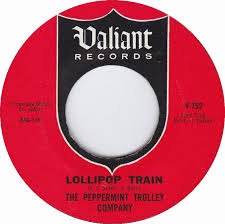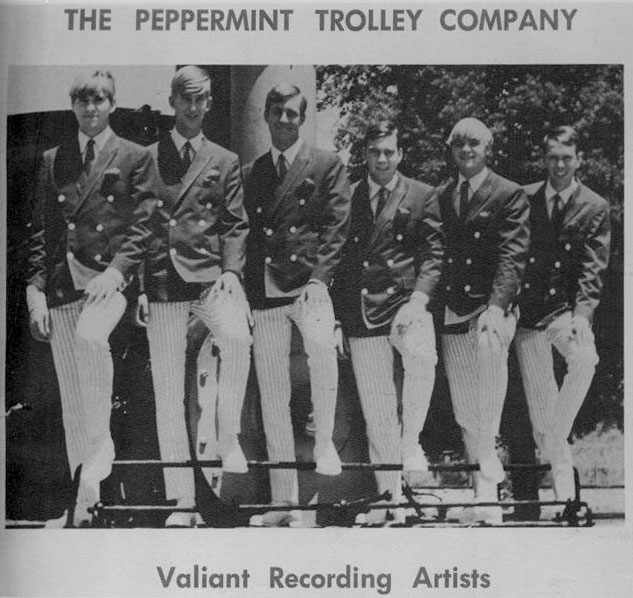
At the Corner of Selma and Cosmo
There are moments in life when a specific place takes on great significance. For me the corner of Selma and Cosmo in Hollywood during the sixties is such a location. I remember it fondly. Indeed, the memory of it holds an almost mythical place in my mind. Looking back decades later, I can see that this corner represents a crucial intersection in my life, and the road I ultimately took.
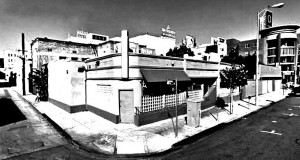
Corner of Selma and Cosmo, home of Moonglow Studios
Moonglow Recording Studio stood on the northeast corner. Revell’s Coffee Shop was right next door on Selma , and around the block north on Cosmo was the underground rock club, Bito Lido’s, where Love, and later the Doors performed. Moonglow was just a stone’s throw from numerous other studios : Jesse Hodges’ Hollywood Sound Recorders, Wally Heider’s, Gold Star, Sunset Sound. A block south on Ivar, was the headquarters of Bob Keene’s Mustang Records. A little brass figure of a galloping horse hung over the door. Keene, who had released Richie Valens’ hits in the fifties, was riding high with the Bobby Fuller Four. Sadly, Bobby’s mysterious demise (Murder? Suicide?) would soon pull the reins in on Mustang. Rene Hall, the great African-American guitarist and arranger, famous for his work with Sam Cooke, had an office on the next block east on Selma. It was a scene, the tail end of the golden age of Hollywood studio rock, and my brother, Jimmy, and I were fortunate to have played a small role in it.
Moonglow Studio is where we spent countless hours honing our musical craft between the summer of 1966 and the summer of 1968. We were just a couple of green, but ambitious kids from the hinterlands drawn by the allure of the big city and the dream of making records. It was such an exciting, fertile time, and we met so many interesting and creative people. Music was all around us, and all our focus was on making sonic magic and striving to capture those good vibrations on tape
Moonglow had had its beginning in 1958, when an enterprising Belgian émigré, R.J. Van Hoogton, a.k.a. Ray Maxwell, decided to try his hand in the music business, building the studio, and starting a record label of the same name. In the early sixties he signed a duo from Orange County called the Paramours, who went on to have several hits on the Moonglow label as the Righteous Brothers, including Little Latin Lupe Lu, and My Babe. Bobby Hatfield and Bill Medley moved on to bigger things, however, and the label folded in 1963. When we entered the picture Moonglow was a studio for hire. The room was small, but comfortable. with a warm, clean sound, and like most of the other studios in the area it had an Ampex four track machine.
A Lesson in Simplicity
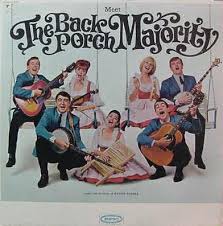
Dan Dalton pictured far right. Lois Fletcher beside him.
July of 1966 was when we hooked up with producer, Dan Dalton, a tall Irish-American with fire red hair, a gift of gab, and charm by the bucket load. Dan had heard our band the Mark V when we auditioned for him over the telephone. We were rehearsing with a local folk singer named Mickey Elly whom we occasionally backed. Mickey, upon hearing us do a rendition of our latest original was so jazzed that he thought the producer he had met and recorded some demos with should hear it. He immediately phoned Dalton. The tune, Bored to Tears, penned by Jimmy, was an unusual hybrid of folk, rock, and…yes… Dixieland. Digging what he heard , Dan put his wife, singer Lois Fletcher on the phone to take a listen as we played the song again. The couple had then driven from their pad in Silver Lake to West Covina to meet with us. They were as impressed with us and we were with them, and within the week , Dalton had booked a session at Moonglow.
Dan, who played tenor banjo and twelve string guitar, had been part of a folk trio with brothers Jack and Wally called the Dalton Boys, and more recently, was a member of the Randy sparks ensemble, The Back Porch Majority, a group which also included his future wife Lois, and Kin Vassy (who later worked with Kenny Rogers, Frank Zappa, and Elvis). The Dalton’s had paid their dues in the urban folk music circuit, rubbing elbows with a lot of musicians and singers who were now crossing over into and changing mainstream pop and rock.
For the previous year and a half, Dalton had been in partnership with Daniel (Danny) Moore. Together they had produced twenty-five acts, and had secured record deals for fifteen of those acts, including Moore’s brother, Mathew, with the Capitol release – Another Face in the Crowd . For our date, Dalton brought in studio musician’s to record the basic track – Danny Moore, Buzz Clifford, and James Fleming on acoustic guitars, Mathew Moore on the piano, Larry Brown, a protégé of Hal Blaine’s, on drums, and an old school Fender bass player, who’d brought along an acoustic bass and tuba, just in case (sorry, I don’t have names for the last gentleman). The engineer on the session was a young cat named Phil Yend. In those days, most of the instrumental parts would go on the basic, which would be pre-mixed before cutting and recorded on to one or two tracks, leaving two or three tracks open for lead, background, and any solos.
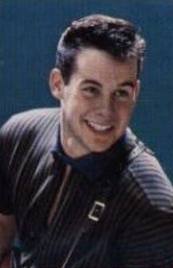
Buzz Cifford – What a voice!
We watched from the booth as they recorded. It was a lesson in simplicity. The emphases was on laying down a cookin’ little two beat rock and roll groove. Matt pecked out an intro on the piano, and off they went. The drums popped and the guitars jangled with rhythmic propulsion. Within a couple of hours the basic track was down.
We came back the next day to overdub the horns and vocals. Dave, Steve, and I gathered around one mic with trumpet, clarinet, and trombone respectively. We were pretty good at blowin’ Dixieland, and within an hour we’d waxed the parts. Dan wanted me to add a hooky glissando smear with the bone. My sense was that it was a bit much, but who was I to say? Ask and ye shall receive. The lick, along with some Herb Alpert hits on trumpet, was most likely combined with the other horns as they were “ping ponged” to an empty track.
It was then time for Jimmy and I to do some singing. As a producer, Dan favored vocals that were clean and precise, which was no surprise, given his folk background. We’d been used to the loose atmosphere at Impression, where our records could best be described as garage rock. Three or four of us would gather around the mic to sing our parts without much direction from the booth. At Dan’s request, only Jimmy and I would be singing on the record. We simplified and fine tuned the parts, and began doing takes. When we got a keeper, we doubled it, using the remaining track. We had us a record, boys!
Lollipop Train
Now we needed something for the flip side. Around this time Dan had gotten hold of a song called Lollipop Train. It was written by P.F. Sloan, a hot songwriter who’d had a string of hits, such as Eve of Destruction by Barry McGuire, the Turtles You Baby, and Where Were You When I Needed You? by the Grass Roots. Dalton had already recorded a basic track for the tune, and tried out several singers on the lead, without success. He thought it might be a good fit for our band, and played it for us. Upon hearing it, Jimmy and I liked the song, which featured a time signature change from 4/4 to 3/4 at the end of each chorus. A date was booked to add instrumental overdubs.
When we arrived for the session, we found horn charts already written out on music stands just waiting for us to play. Dalton had hired a professional. The arranger, a friendly middle aged gentleman with glasses who looked like a college professor, had recently charted the arrangement for Bobby Hebb’s smash hit, Sunny. We were duly impressed. As we played, I could hear in my earphones how well the parts worked over the basic. It was exciting and dramatic, and I loved every second of the process. With the horns now in the can, our pianist, Brad, began fiddling with the drawbars on the Hammond organ, and quickly came up with a calliope like sound that worked well with the theme and time signature. In one pass it was printed. There was one last thing. The track featured a two bar drum turnaround after each chorus with a four on the floor from the kick. Dan, wanting to fatten up the sound of the bass drum, asked our drummer, Dick, to beat a steady four using a mallet on his drum case. It did the trick! Making records in those days required ingenuity, and a willingness to fly by the seat of one’s pants. When it worked it was outasight!
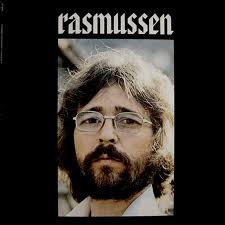
James Fleming Rasmussen
To record the vocals, my brother and I drove into town alone a few days later. It was decided that Jimmy would sing the lead. I observed from the booth. The engineer clicked the start button on the machine. “Rolling” he said. Jimmy cupped his hands around the earphones, closed his eyes, and out came this edgy voice that perfectly captured the song’s angry tone. It was a ballsy, snarling lead in the folk rock bag, and I must say, it took me a bit by surprise. I’d never heard him sound quite like that before. I was proud of him, no end. The record was coming together!
All that was left were the background harmonies. I was paired with Buzz Clifford to work out the parts. The singer /songwriter had already been in the business for a decade, and had played a part in rock and roll and doo wop’s wild early years. In 1960 he’d had a crossover million seller with the novelty record Baby Sittin’ Boogie, which I remembered dancing to in junior high, and had survived years of disappointment and obscurity by staying creative, and keeping current with what was happening in pop music. I was both overjoyed and intimidated to be working beside such a pro. Buzz was cool, though, and really put me at ease. The man was relaxed yet so focused, a truly great studio singer. He knew exactly what direction to go in, and I followed. I learned from Buzz to pinpoint my concentration like an archer, yet at the same time to jump in and sing with abandon, holding nothing back, and having unbelievable fun in the process.
Coffee at Revell’s
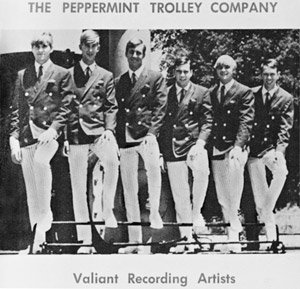
Valliant Records promotion for the Peppermint Trolley Company
After the session, we all went next door to Revell’s for a bite. The old style coffee shop was owned by a Greek family. Mr. Revell, the amiable white haired patriarch manned the cash register. Like so many Greek owned restaurants, the food was fresh and delicious. Jimmy and I shared a booth with Buzz and James Fleming Rasmussen. James was a bespectacled Dane with a Beatle’s haircut. in his late twenties, he had been a pop star in Denmark, having started the first Rock and Roll band in that country, James and his Jamesmen in 1955. He’d only been in America for a year, and spoke with a heavy Danish accent, which we found amusing.
The waitress, who addressed me as “Honey”, brought us our coffee. Buzz, who was in the middle of one of his stories, grabbed the sugar jar and, talking all the while, began pouring what seemed like an endless stream of white granules into his cup. James’s head began to bob up and down as his magnified eyes followed the sugar flow. Jimmy and I started to laugh. Buzz finally ended the pour with a twist of the wrist. Noticing that we were cracking up, he asked with a puzzled look – “What?”
James, turning his head to look directly at Buzz, said ” I can see you like a little coffee with your sugar. I thought that would never end.” the Danish accent added to the hilarity of the situation. I sipped my coffee and savored the moment, enjoying the company of our new friends, whom we learned had met each other in this very cafe about a year before.
At Dan’s request we changed the name of the band. The moniker was chosen by committee, but I remember Jimmy piecing it together. Regrets about the name? Absolutely, but one must keep in mind that in the pre counter culture, pre hippie days of July, 1966, the Peppermint Trolley Company was a much hipper sounding name than it would appear to be later.
Dalton had decided that Lollipop Train was the stronger of the two, and should be the A-side. There was no disagreement there. He shopped the disc, and got us a singles deal with Valiant Records, a small L.A. based independent, and the home of the Association, whom we had met when we played Disneyland the previous June. We loved the band, and were thrilled to be on the same label.
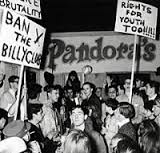
Young club goers protest police harassment.
Dan Dalton and Danny Moore were no longer working together as co producers. We weren’t privy to what exactly went down between them. Perhaps Dan’s decision to produce us alone had something to do with it. I can say that Jimmy and I respected and liked Moore, and would continue to have some relationship with him for several years.
“Hippie Riots” on the Sunset Strip
During this time that we were recording at Moonglow, the Hollywood Rock club scene was in its apex. Teens were flooding the sidewalks of the Sunset strip and elsewhere to get into places like The Trip, Pandora’s Box, and Ciro’s. This manifestation of a burgeoning youth movement really freaked out the established elites and their enforcers, the L.A.P.D., who never seemed to miss an opportunity to escalate a situation and ultimately come down with a heavy hand. The cops began an intense crackdown on the kids. We witnessed some police harassment around the corner at Bito Lido’s. A teen-age girl wearing the straight long hair that was all the fashion had just exited the club singing the Lovin’ Spoonful’s Summer in the City.”Hot town, summer in the city.” she sang as she snapped her fingers, “Back of my neck’s gettin’ dirty and gritty”. Her happy mood must have pissed off a nearby cop, because he promptly threw her against a squad car, cuffed her, and pushed her into the back seat, no questions asked. Arrested on suspicion of having too much fun.
Throughout the late summer, we felt an exciting momentum. We shopped for stage clothes, had photos taken, auditioned for agents , and played some gigs. In September the record was released. I remember gripping the 45 in my hand and eyeballing with satisfaction the red Valiant Label with our band’s name on it. The local inland Empire radio stations, KFXM in Riverside, and KMEN in San Bernardino put in into rotation. It sounded absolutely wonderful on the car radio.
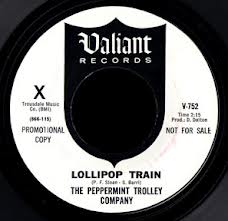
Label for the 45 Single of Lollipop Train
Autumn
I’m afraid I got my hopes up too high, though, and put my eggs in one basket yet again. Just as in the previous year when our record I’m Through With You was released and got airplay at the end of summer, so it was with Lollipop Train. And just as the Mark V single fell out of rotation as summer turned to fall, so it was with the Peppermint Trolley Company release. I was in my second year at community college, Jimmy was a freshman at UC Riverside, living in the dorm, no longer at home. All the other guys were in college as well. I went through a period of deep disappointment, and looking back now I can see just how seriously depressed I was. I was lost, lonely, and without direction. We continued to do the occasional gig, but that fire was gone. Music was not a hobby for me. I wanted it to be my life. I wanted swim in it. I yearned to get back into the studio, and found it difficult to concentrate on my studies. I would go for long walks through the streets of Redlands and take solitary hikes into the hills.
In mid October, Dan called to say that he and Lois would like Jimmy and I to come to town and be their house guests for a week-end. Jimmy and I hopped into the family’s green ’58 Plymouth station wagon with the huge vertical fins, and headed for the city. Interstate 10 was to me as the Mississippi was to Mark Twain. It represented entry into a wider sphere. Yes, it was a world filled with potential pitfalls, but it was also a world ripe with possibilities. Riding the freeway’s westward flow always got my adrenalin going. My heart would race as we passed the old Brew 102 plant, which stood at the edge of downtown L.A., with its huge sign, and its aroma of malt mash.
We had a productive stay with the Daltons. Dan emphasized that he could see a future for Jimmy and me as artists. The two of us had a great blend, he said, like the Everlys or the Beatles , and he believed in us. He pitched some ideas and songs. It was a nice pep talk and really gave a boost to my flagging spirits.
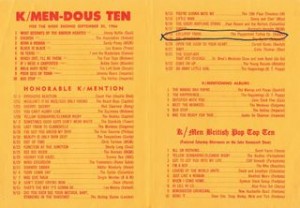
Our record in rotation on San Bernardino’s KMEN
In November, I came down with a serious case of mononucleosis. Man, was I delirious! Psychedelics got nothin’ on mono for hallucinating like a fiend. I was confined to bed for weeks, and had to drop out of school. After the fever broke, I settled into recuperation mode. I listened to a lot of music, from Simon and Garfunkel to James Brown and everything in between. I read books: Henry David Thoreau’s Walden Pond, Kahlil Gibran’s The Prophet, and the words of Jesus. I also watched TV, mostly junk, but did happen to catch a rock musical written by Burt Bacharach and Hal David called On the Flip Side, which starred Ricky Nelson and Joanie Somers. It was inspiring to see characters who looked a bit like me singing “Fender mender, fix my guitar. I want to be a real big record star.” It made me wish I was back in the studio.
New Beginnings
By mid December, weak but recovered, I was able to get up, get out, and move around. It felt so good just being alive and healthy. Our drummer friend, Casey Cunningham, urged Jimmy and me to rehearse with him and a couple of great local rock musicians, Bobby Anglund on guitar, and Pete Sampson on bass. I moved from trombone to keyboards. Though this unit was short lived, and didn’t go anywhere, it was a great experience and whet my appetite for putting together an original rock band with Casey and Jimmy.
The year was coming to a close. The Mark V had been together since 1962. It had been a great run. At the time I didn’t know, but in a few weeks Dave would leave the group, leading us to disband shortly thereafter. On New Year’s eve 1966, we played one of our last gigs, a private party in Beverly Hills. On the drive back home in the family’s ’59 El Camino, seated between Jimmy at the wheel, and Brad riding shotgun, in a sleep like state, I stared at the glowing AM dial as it filled the cab with beautiful sounds – Pretty Ballerina by the Lefte Bank, and Ruby Tuesday by the Stones. Ah, I thought – Jimmy, Casey, and I could make music like that. We were driving through the night, and into the new year. I vowed that 1967 was going to be a year of change, of growth, of pursuing the dream. The radio began playing a new record by the L.A. band, Love, a strange, and dreamy song called Orange Skies.
Back on the Corner
My mind drifted back to the summer, to the corner of Selma and Cosmo …
I was hanging out in front of Moonglow. The sun was going down. A figure came walking up the street. He was an African-American, dressed in wild clothes. He wore tinted granny glasses on his nose , and a blue scarf draped around his neck. I recognized him right away as Arthur Lee of Love. He rounded the corner and headed north on Cosmo, on his way to Bido Lito’s.
Forty -six years later my mind would again drift back to the moment and I would write a song about this brief experience:
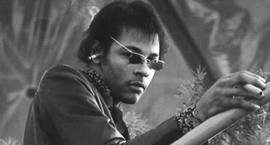
Arthur Lee of Love in shades.
In the twilight a figure approaches
Blue scarf flowing wild and free
On the corner of Selma and Cosmo
I cross paths with Arthur Lee.
Shades of Love
Colors of the moon
A voice in the wilderness
But who’s to hear the tune?
In the twilight the music is playing
A mystic chant so wild and free.
On the corner of Selma and Cosmo
I crossed paths with Arthur Lee.
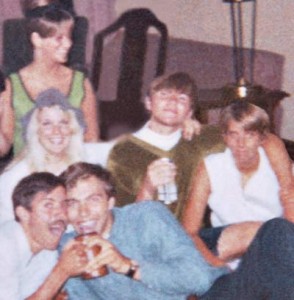
Danny with brother Johnny and friends in the summer of 1966
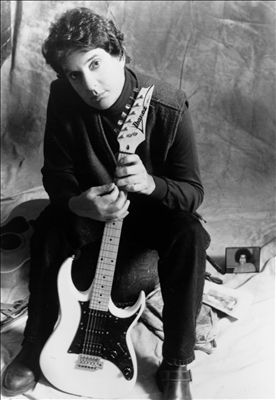 achieved the public acclaim that he so richly deserved,but he is deeply respected today by musicians and musicologists. Although I never met the man, I am proud to have had a small musical connection with him through the Peppermint Trolley Company’s single release of Lollipop Train.
achieved the public acclaim that he so richly deserved,but he is deeply respected today by musicians and musicologists. Although I never met the man, I am proud to have had a small musical connection with him through the Peppermint Trolley Company’s single release of Lollipop Train.